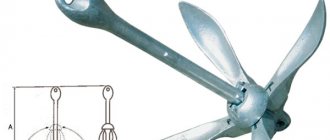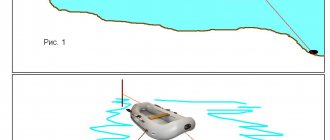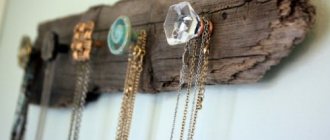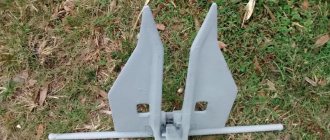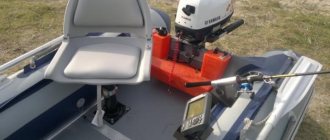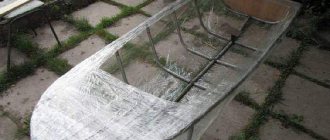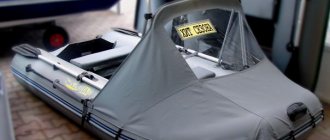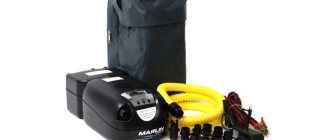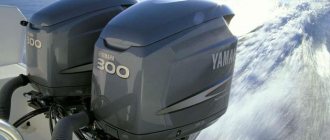Requirements for anchors for an inflatable boat
An inflatable boat made of PVC is distinguished by maneuverability and lightness, however, there are a lot of designs of boats made of this material and each has its own differences. Despite all the diversity, there are general requirements for anchors for inflatable boats and they are as follows:
- Reliability of securing the boat under any conditions.
- Compact and minimal weight.
- Convenient design.
- Durability, corrosion resistance.
- Folding option if possible.
The anchor, as a holding force, must have an appropriate design and optimal weight, which is calculated based on the vessel's displacement. This calculation will be presented below.
The choice of anchor type and weight is influenced by the following factors: • Bottom topography; • Current on a reservoir; • Wind speed; • Weather.
If the current is strong or the weather is unfavorable, you should play it safe by securing the boat with two different anchors, one of which has rotating blades.
To avoid damaging the hull of the inflatable boat, it is better to use a folding anchor carried in a case; it will not cut a hole in the fabric.
Basic design requirements
- High holding force, which directly depends on the anchor mass. The boat must stay firmly on the water, regardless of the wind and movements inside the boat, or the current and waves.
- Ease of removal from hooks. It is also important here not to lose the anchor.
- Compact to take up little space during transportation.
- Light weight.
- Corrosion resistance.
- Convenience for specific swimming conditions (depending on the soil of the reservoir).
How to catch more fish?
How to calculate anchor weight
Calculating the weight of the anchor can be done in two different ways based on the parameters of the boat:
- Method 1—for calculation, take the mass that the boat can hold. Here the mass of the anchor depends on the displacement of the boat and should be 10% of the total mass. For example, a boat with a displacement of 250 kg should be equipped with an anchor that weighs 2.5-3 kg.
- Method 2—the length of the boat is used. In this case, the following formula is applied: anchor mass = 1% L of the boat, where L is the length of the vessel. Thus, a boat with a length of 320 cm must be equipped with an anchor weighing at least 3.2 kg.
How to make a good boat anchor?
The stores do not yet sell anchors that meet all the requirements of fishermen, which is why this question arises.
- Find out fishing conditions. You need to choose a fishing spot, find out the weather, and, if possible, explore or ask about the soil at the bottom.
- Choose a model based on weight and type.
- Prepare the necessary material and equipment.
- Do it yourself, using literature, the Internet or advice from other fishermen.
Such an anchor, made with your own hands and “for yourself”, will serve and delight you for a very long time.
How to determine the weight of the anchor and the dimensions of the anchor rope?
The mass of the anchor can be determined in two ways:
- By calculation, based on formulas.
- Looking at special tables.
The mass of the anchor will be approximately 1% of the length or mass of the boat.
For a boat weighing 420 kg, an anchor weighing 4.2 kg is suitable.
For example, for a boat with a length of 280 cm, you can use an anchor weighing 2.8 kg.
Anchor ropes can be:
- natural ones , which have hardly been used for a long time (sisal, hemp).
- synthetic , which, due to their strength, resistance to rotting and the influence of the sun (nylon, nylon), occupy a leading position.
The length of such a rope should exceed the depth by 4-6 times.
If you know that there is a strong current in the fishing area, then it is better to have a cable with the required length. Which will naturally increase the holding force of the anchor itself.
Overview of types of anchors for inflatable boats
The evolution of the boat's shape did not undergo such unimaginable deformations as the anchor had to undergo.
Sailing is a fairly ancient craft, and an anchor is an integral part of any small boat.
At the moment, a wide range of types of anchors are offered for use specifically on inflatable boats.
- Admiralteysky. A classic option that is equally effective on different bottom soils, but in terms of the degree of coupling reliability it is inferior to other models. Currently, PVC boats are practically not used.
- Hall's anchor, modification - Matrosov's anchor. It has increased holding power and is more effective on pebble bottoms. The Hall anchor is considered non-hooking, however, its design needs to be modified by equipping the lower part with a ring for the second rope, then the anchor can be easily pulled from the hook.
- Danforth anchor - when applied to a boat, PVC is not suitable for use on a pebble bottom, it is not convenient in strong currents, since it is light and does not fall where you expected. It's not foldable. One of its disadvantages is that it burrows heavily into the ground.
- Bruce's anchor. The structure and principle of operation is similar to Danforth and Matrosov anchors; it is better to use it on a hard bottom covering, but in its soft counterpart such anchors hook too firmly and it becomes difficult to lift them.
- Attwood. This anchor has a mushroom shape and is relatively compact, which is an advantage when installing it in an inflatable small-sized PVC boat.
- Anchor cat. A very popular model of folding anchor. Its popularity should be emphasized not only because of its versatility and excellent performance in rough bottom conditions, but also because it is experienced fishermen who modify it “to suit themselves.”
- Neo-anchor. A relatively recent invention by Japanese developers, the special design is fastened quite reliably in any conditions and facilitates easy wedging of the anchor, which makes life much easier for fishermen.
Drifting. It is also called floating. There is also a version of a canvas anchor; it is designed to slow down drift with the current, but it is rarely used on PVC boats, for example, for trolling.
Although the choice of anchors is quite large, still 2 models will be most acceptable for PVC boats:
Anchor cat
Lightweight design, has a weighted rod and relatively flexible legs, and comes in folding and regular versions.
Store-bought specimens are usually modified by fishermen, taking into account the fishing location.
A snagged bottom is an excellent trap for a grapple anchor; encountering a sufficiently large snag will entail parting with the anchor that is firmly attached to it.
The assortment includes anchors weighing from 1.5 to 12 kg, with weight increments of half a kilogram.
Mushroom anchor
It is also called anchor-plough, daisy, they differ in different shapes, but the main similarity is their motionless paws. The anchor arms are also covered with PVC film, which very well protect the boat material from damage.
Types of anchors
Based on functionality, three types of anchors used on PVC boats can be distinguished.
- A gravity anchor that holds a watercraft using its mass.
- The anchor, which has claws, holds the boat on hooks or plates hooked to the bottom.
- A drifting or floating anchor, which will be useful for some types of fishing, for example, raft fishing, quok fishing, and trolling.
What needs to be taken into account when making homemade metal anchors is that when there is a wave, the boat is tossed up on the wave and the anchor can damage it.
Gravity anchor
In order to keep your boat in place when fishing on a lake where the currents are weak or non-existent and the vessel moves under the influence of the wind, it will be enough to simply lower the weight to the bottom.
For example, it is enough to put stones or sand in a bag and use it as an anchor.
The pyramid-shaped anchor cast from lead performed very well; it is compact, does not damage PVC fabric, and is a successful option. What is important here is the design itself, which is much easier to pull out than just a load.
As a load, many people use: cast-iron brake discs, weights from dumbbells or barbells, cast-iron balls, tracks from a tractor, etc., but on soft ground these devices will tighten tightly, you will have to cut the rope and say goodbye to your anchor.
How to choose
It is impossible to name any one, best model. The choice will be influenced by fishing conditions.
When fishing with a spinning rod, you need to be mobile, quickly unanchor and move to another location. This means that when spinning fishing, the anchor should not be heavy and can be easily pulled out of the water.
When float fishing, when no movement is required, a heavy anchor will provide you with the necessary stability and maximum immobility of the boat.
A muddy or sandy bottom is ideal for a claw anchor. Where the bottom is dense and rocky, a heavy mushroom-shaped anchor will work well.
What can be used as weight for a boat?
The use of various kinds of improvised means (for example, cobblestones or pieces of iron) as a load for a boat can only be used if the bottom of the reservoir on which fishing from a boat is carried out has a rocky bottom. In other cases, for example, when the bottom of a reservoir is muddy or sandy, the use of such cargo is ineffective.
Some fishermen use a variety of improvised means as cargo. As a rule, these are bricks, stones or even pieces of iron. However, using such cargo when fishing from a boat is fraught with loss of time, inconvenience during transportation, and even damage to the craft itself.
Therefore, most fishermen know several ways by which they can make anchors that are perfect for PVC boats without high costs.
There are several types of cargo, or rather, according to its purpose it can be:
- Main (also called nasal).
- Stern (or as it is called verp).
The main load is necessary for stable resistance of the boat to the influence of wind, waves or current. A stern load is necessary for axial stabilization of the craft relative to a specific area where fishing is carried out.
Using a boat weight while fishing is also necessary to comply with safety measures. After all, its use ensures the stability of the boat in the case when the shoreline of the reservoir is on the leeward side.
What kind of anchor is used in the current?
The current imposes its own requirements on the stability of the inflatable boat. In the current, two anchors are usually thrown - bow and stern.
One of them will have a good hook, on the bow, and the second will have a lot of weight, on the stern. This way, you will avoid roughness and anchor the boat perfectly in the right place.
In a current, your boat will be constantly exposed to the force of waves and water flow.
You need to choose an anchor taking into account the structure of the bottom. The crampon-type design will grip well, but if the bottom is loose and soft, it will become increasingly bogged down. On such a bottom, it is better to prefer an anchor without claws.
How to protect an anchor from drowning
Making an anchor is only one stage, and not the most important one. The main thing is to be able to use your product correctly, fixing it on the bottom. This requires experience, so you need to be patient to learn how to cast anchor like a true sailor.
Since the most popular type among fishermen is the “cat” type, we will describe in detail the rules for handling it. The device should be tied to the bottom loop using a nylon rope or a thin tie. Thanks to such materials, you do not risk breaking the cable if you jerk the anchor sharply.
If the current is very strong, you need to install two “cats” - at the bow and stern. The watercraft must be positioned longitudinally to the direction of the current so that it is not overturned by the movement of water. A boat can only be installed against the current with additional weights.
It is necessary to place the boat along the river flow in the following way: you need to go a little upstream of the expected place of downtime and throw an anchor, selecting the strength of the rope depending on the weight of the product. When installing two “cats,” the second one should be installed only after the first cable is tensioned in the direction of the flow.
In this video you can find detailed instructions for making a cat-type structure with your own hands.
PVC boat anchor halyard
For all these anchor options, a synthetic halyard or rope with a cross-section of 7 to 10 mm is recommended. This is the optimal size with sufficient tensile strength.
The range of such a seemingly simple accessory for a boat is quite large.
Natural materials here give way to synthetic ones. Hemp and sisal are still on sale, but nylon or nylon are in demand.
It is worth highlighting the reasons why synthetics are a priority:
- Biostability, also known as resistance to rotting pathogens.
- Resistant to temperature fluctuations and sun exposure.
- High strength.
- Affordable price.
- Moisture resistance.
According to the standard, the cable needs a cross-section at which its breaking force will exceed the mass of the anchor by 70 times. For synthetic materials, this figure is 7-10 mm with a breaking load of 1000 kg.
To determine the required length for the anchor halyard, you should know the approximate depth of the body of water where you plan to use the anchor.
The length of the rope will depend on certain conditions. In a strong current, the bow anchor will be better held by a longer rope, 5 - 6 times greater than the depth. For a heavy anchor, the halyard should be shorter to prevent the boat from yawing.
The correct way to lock the anchor halyard is by the eye-ring or the eye-handle, and not by the handrail.
Where to buy an anchor
- St. Poltavskaya, 33, tel.
- Ave. Dezhneva, 9, tel.
- St. Belomorskaya, 4, tel.
- St. Shkolnaya, 73 bldg. 2, tel.
- Vitebsky Prospekt, 11 lit. 3, 2nd floor, tel: 8 (812) 748-25-38.
- Tallinskoe highway, 40a, pavilion 21, tel.
Despite the fact that many fishermen pay little attention to the choice of anchor, do not follow the opinion of the majority. A reliable and correctly chosen anchor will help you avoid losses and spend time with pleasure, which will prevent the boat from dangling and will serve you for many years.
Folk sign: If dew does not appear on the grass and dries quickly, the weather will worsen!
How to choose an anchor for a PVC boat?
Among many owners of inflatable PVC boats, there is an opinion that it is not necessary to use an anchor to hold the vessel in place - they are confident that this role can be fulfilled by any load: a track from a caterpillar, a piece of rail, a backing rail plate or a bunch of stones. That's why most people use such homemade anchor devices, completely ignoring the presence of special boat anchors.
An improvised homemade anchor, the principle of operation of which is based solely on massiveness, is good in the only case - if the bottom of the reservoir is rocky and dense, which does not allow the anchor's legs to catch well on the ground. In all other cases, it is much better and more convenient to use hooked anchors.
Disadvantages of improvised anchors
- The high weight (from 10 to 15 kg) makes handling such an anchor inconvenient, making it difficult to remove and clean from bottom silt and dirt;
- Lack of standards can result in damage to the boat from sharp edges;
- Low holding capacity even with medium flow;
- Large dimensions.
Unlike improvised items, a hooked anchor is much more compact and convenient, while providing several times better traction with the ground and allowing you to keep the boat in place even in strong currents.
Criteria for choosing an anchor for an inflatable boat
To choose a good and reliable anchor for an inflatable boat, you need to know the criteria by which they should be selected. There are several such criteria:
- Compactness. Boat anchors have a folding design to take up little space during transportation. In the working position, the paws unfold and engage the ground, and in the transport position they fold and the anchor decreases in size several times;
- Reliability of fixation. A good anchor should hold the ship even in strong currents or gusty winds;
- Easy to get on and off the hooks. If this is not the case, you risk leaving the anchor on the bottom on your first voyage;
- Low weight. An anchor weighing 3 kg has a holding force of 300 kg - this is several times more than that of a track weighing 15 kg.
- Corrosion resistance. Good anchors are made of stainless alloys, gray cast iron, or coated with a special anti-corrosion compound.
DIY PVC boat anchors
The price of PVC boats is not too hard on the pocket, so almost all fishermen can afford them. To hold the boat on the water, many fishermen use all sorts of available means: blanks, sandbags, rails, bricks, etc., but they do not catch on the ground in the reservoir.
Therefore, it is better to buy or make your own anchor that is suitable for your fishing conditions.
Types of boat anchors
There are a large number of anchors for small vessels, but as practice shows, the most popular for inflatable boats are two types: the Danforth anchor and the cat anchor. They are quite compact and convenient, cost little and are therefore widespread. At the same time, they differ significantly from each other, having their own advantages and disadvantages.
Danforth anchor design
The Hall-Danforth anchor has a monolithic non-folding structure. This projects its main drawback - its large size compared to a folding grapple anchor. But at the same time, thanks to the wide pointed legs, such an anchor is able to bury itself deeply into the ground, which is very important on a muddy or sandy bottom, and therefore has a very high holding force. An anchor mass of 2 kg is enough to hold a boat weighing a hundredweight.
Anchors of this design are made of painted steel or galvanized steel. The latter option is preferable, since it is more resistant to corrosion and can resist it for three to four seasons.
Anchor cat
Unlike the Danforth design, the folding grapple anchor has a design in which the legs are pressed against the spindle in the stowed position. Thanks to this, such anchors are convenient to transport, and the grip, although less than that of the Danforth design, also provides acceptable grip on the ground. That is why they are more common, since such an anchor, together with all the equipment, takes up about half of a fishing bucket.
There are two options for grapple anchors: with a yoke design and with paws secured using a sliding clutch. The second option is more reliable and convenient to use, since in the working position the paws are fixed rigidly, and on the trend an eye is installed for attaching a cable with a buoy. An anchor with a yoke structure is subject to wear - the hinge joints that hold the legs become loose over time and collapse upon impact, which is why the anchor ceases to perform its function.
Homemade anchors for PVC boats, manufacturing examples
So, the reservoir, weather conditions and features of the upcoming fishing are determined, the nature of the bottom is known. The type of anchor has been determined, the design has been developed (it’s best to get it or make a drawing yourself, you can download it from the Internet), the weight has been calculated and the appropriate rope has been selected. You can start manufacturing. In addition to cutting metal with a grinder and drilling, plasma cutting may be required. The vast majority of technologies also require a welding machine.
Anchor cat
An excellent option for use with PVC boats 3-4 m long in calm weather. The folding arms are mounted on a coupling sliding along the central rod. Before carrying the anchor, the arms must be secured at the bottom. The working position of the paws is fixed at the top using cotter pins. These cotter pins can be easily cut off if you need to remove a stuck anchor.
If windy weather is expected, the structure needs to be weighted. And, sometimes, in very significant ways!
Materials for production:
- A metal pipe (possibly a rod) with a diameter of 30 mm, length within 20...30 cm and, additionally, a piece of pipe slightly larger in diameter, 2...3 cm long. The short pipe must be placed coaxially on the long pipe and be able to move freely along the axis .
- Mounting rings, 2 pcs.
- Metal sheets 4...6 mm thick, from which the following blanks should be made: strips 10...15 cm x 2 cm, 4 pcs.;
- strips 4...5 cm x 2 cm, 4 pcs., rounded edges.
- strips 3 cm x 2 cm, 8 pcs., rounded at one end.
- paws in the form of a pointed triangle, 4 pcs.
Manufacturing technology:
- 4 of the 8 strips measuring 2x3 cm are drilled (one hole with a diameter of 5...7 mm is made). The same holes are drilled in medium and long strips, and in the middle ones you need to make 2 holes along the edges.
- Strips of 2x3 cm with holes are welded to a long pipe and will serve as brackets for attaching the paws.
- The remaining 4 strips of 2x3 cm are welded to a short pipe .
- Long strips are narrowed on a sharpener, then triangles are welded to them. An incision is made in the middle of the strips, the workpiece is folded and welded. This is how 4 paw horns are made.
- A short pipe is put on a long one, the welded strips on both pipes are connected in pairs with earrings (strips 4...5x2 cm) using rods.
Selecting the mass of the anchor
There is a common and simple way to select an anchor for a boat - this is the ratio of the mass of the anchor to the length of the boat. That is, 1 kg of mass is enough to hold a boat 1 meter long. For registered vessels, the Rules require an anchor weighing at least 5 kg; if it is missing, the boat owner will face a serious fine.
Therefore, the best option, say for a three-meter boat, would be 2 anchors of 1.5 kg each. This will make it possible to carry out a stretched setting - with one anchor from the stern, the other from the bow, in order to “tightly” fix the vessel. If necessary, the anchors can be strengthened with a piece of chain, which is used in the form of a halyard. This is exactly what many boat owners do - they equip the vessel with an anchor of the minimum permissible weight, and, if necessary, reinforce the weight with several short pieces of chain with carabiners in order to increase the required length if necessary.
For example, just one meter of chain with a diameter of 10 mm increases the weight by 2.2 kg. Moreover, the chain can be used in two ways:
- A piece of chain is tied to the spindle like a halyard and with its mass presses the spindle to the bottom, improving grip and establishing the optimal hook angle. In this case, the jerks of the boat that arise as a result of waves or wind are absorbed by the chain.
- A section of chain is simply wrapped and secured around the trend, increasing the mass of the anchor and shifting the center of mass towards the trend. Thus, if necessary, the mass of the anchor can be increased 2-3 times with a fairly simple tool.
Choosing a halyard
Choosing the right halyard is very important, since there is a high risk that when choosing an anchor, the halyard will get tangled, break, or cut your hands. Some boat owners purchase inexpensive and durable halyards made of polyamide thread - but such halyards are inconvenient to choose, as they cut your hand and get tangled easily.
The best option is a flat sling or a thick cord for an anchor with a diameter of 7-10 mm. It is imperative that they are made of synthetics - this material has positive buoyancy and even if the end falls into the water, it will not sink. Both options have their own characteristics - it is more convenient to pull the sling with your hands and it does not get tangled in the bay, but in a strong current it “sings”, and the cord does not have this drawback.
Manufacturing of anchors according to the Kurbatov system and pyramidal type weights
The Kurbatov system is a device that works great when fishing on a rubber two-seater boat. It copes well with the impact of a small current and wind force on the boat, which does not exceed 6 m/s. This design is made of a forked clamp and strong wire. In addition, the design includes one paw, the inclination of which is 45 degrees. Thanks to the elongated rod, this design is able to penetrate the bottom of the reservoir, regardless of the angle at which it was thrown into the water.
It is worth noting that this load, used when fishing from a two-seater boat, has such qualities as compactness and low weight, which can be very important during transportation and quickly lifting the load from the bottom of the reservoir.
In order to make such a load, it will be necessary to use the following materials:
- wire made of steel, the diameter of which is about 8 millimeters;
- steel sheet, the thickness of which does not exceed three millimeters;
- a rod made of steel, the diameter of which is 13-15 millimeters.
Kurbatov's system works great when used on boats whose length does not exceed 5 meters. The weight of this load varies between two or three kilograms, so if you plan to fish in a body of water with a strong current, then it is necessary to provide in advance for attaching an additional load to the main load, which weighs about five kilograms.
Pyramid-type weights for PVC boats are classified as gravity anchors. This anchor can be made using several methods. The first method is aspic. To make a pyramidal anchor in this way, you will need to stock up on 5 kilograms of lead. It can be obtained from an ordinary battery, which is used in cars and has already exhausted its resource. You will also need a sheet of iron and a small piece of wire made of steel.
It is necessary to make a mold from an iron sheet that, in appearance, forms a pyramid. This mold must then be filled with pre-molten lead. The steel wire must be twisted into a ring and inserted into uncooled lead, which is in an iron mold.
The second method by which you can make a pyramid-type anchor is composite. In this case, as materials for making the load, it will be necessary to use several sheets of metal that have different sizes and a stud with a pre-cut thread. You need to make holes in the center of the metal pieces and then thread them onto a pin.
Initially, smaller pieces of metal are collected, and then larger ones, and so on in ascending order. After the required number of metal pieces has been collected, they must be secured using an ordinary nut.
Anchor snagging and how to deal with it?
The main problem of the anchor is getting caught on the bottom topography: large stones, snags. Once the anchor gets caught, it is difficult to release it. Therefore, when choosing, you need to pay attention to the design of the trend - it must have an eye at the end for a buoy - in addition to a cable that is attached to the topbuoy. If the anchor gets caught on a snag or driftwood, just pull the buoy rope and release the anchor.
Another option is to pre-install a sliding pin on the spindle eye with a small breaking load so that it can be torn by hand, and attach the end of the halyard to the trend. When hooked, a strong jerk will be enough to release the anchor.
